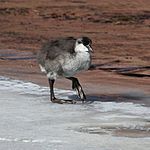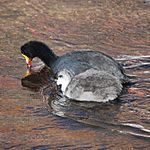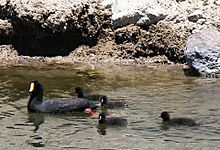Giant coot facts for kids
Quick facts for kids Giant coot |
|
|---|---|
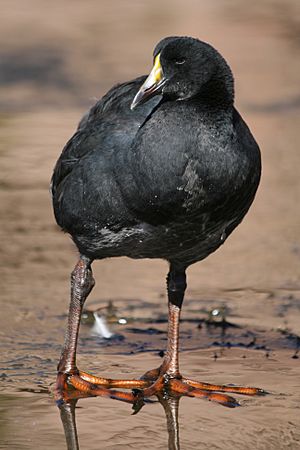 |
|
| in northern Chile | |
| Conservation status | |
| Scientific classification | |
| Genus: |
Fulica
|
| Species: |
gigantea
|
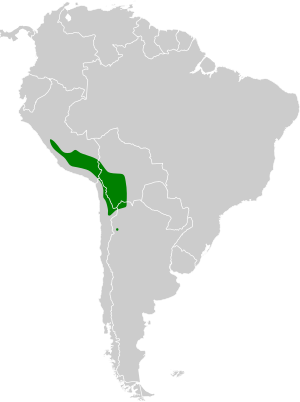 |
|
The giant coot (Fulica gigantea) is a large bird that belongs to the family Rallidae, which includes rails, gallinules, and coots. You can find this amazing bird in parts of Argentina, Bolivia, Chile, and Peru.
Contents
What is a Giant Coot?
The giant coot is the second largest living member of its bird family, only smaller than the takahē from New Zealand. Adult giant coots are about 48 to 59 cm (19 to 23 in) long. They are quite heavy, weighing around 2 to 2.5 kg (4.4 to 5.5 lb). Because of their weight, adult giant coots cannot fly! However, younger birds are lighter and can fly.
Both male and female giant coots look similar. They have a big body and a head that seems a bit small for their size. Their feathers are a dark, slaty gray color, which is even darker on their head and neck. Underneath their tail, they have some white streaks.
One unique thing about the giant coot is its bill and legs. Their bill is deep red with some yellow at the base. They also have a yellow shield-like plate on their forehead. Unlike other coots, their legs and feet are a deep red color. Young giant coots have darker gray feathers underneath and lighter bills and legs than the adults.
Where Do Giant Coots Live?
Giant coots live in the high mountains of South America, specifically from southern Peru, through western Bolivia, and into northern Chile and northwestern Argentina. They are found in a high-altitude area called the Altiplano. This landscape is usually quite barren, meaning it doesn't have many trees or plants.
These birds love to live near ponds and lakes, especially those with lots of weedy plants in the shallow parts. They usually live at elevations between 3,600 and 5,000 meters (11,800 and 16,400 ft) above sea level. Sometimes, they can even be found as high as 6,540 meters (21,460 ft)! Occasionally, they might wander closer to the Pacific coast.
Giant Coot Behavior
How Giant Coots Move
Adult giant coots usually stay in one place. If a small pond freezes over, they might walk to a larger area of open water. Younger giant coots, however, can fly and often move to new places by flying at night.
What Giant Coots Eat
Giant coots mostly eat water plants. They especially like plants from groups like Myriophyllum, Potamogeton, Zannichellia, and Ruppia. They also eat algae, but they avoid a type of algae called Chara.
They usually feed on the surface of the water. Sometimes, they might dabble like a duck (dipping their head into the water) or even dive underwater to find food. They also graze on plants along the shore.
Giant Coot Reproduction and Life Cycle
Giant coots can breed at any time of the year, but they lay most of their eggs during the local winter months of June and July. They are monogamous, meaning a male and female pair stay together. They are also very territorial, protecting their nesting area.
They build a huge nest out of plant material. They pull plants from the water and pile them up in water about 1 meter (3.3 ft) deep. When the nest is new, it floats. But as the parents keep adding more material to it, it usually ends up resting on the bottom of the lake.
A female giant coot usually lays three to seven eggs. Both parents take turns sitting on the eggs to keep them warm until they hatch. The young chicks eat fresh plants that the parents add to the nest. They also eat small animals like amphipods (tiny crustaceans) and tadpoles that their parents bring to them.
Giant Coot Sounds
Male giant coots make interesting sounds. They have an "alternating gobbling or laughing 'houehouhouhouhoou'" sound and also low, growling 'hrr' or 'horr' sounds.
Female giant coots make "low, crackling 'chee-jrrrh'" and "low squeaking or cracking sounds." When a female is with a male, she might also make a soft 'hi-hirr hirrr hirrr...' sound.
Giant Coot Status
The IUCN (International Union for Conservation of Nature) has evaluated the giant coot and listed it as a species of "Least Concern." This means they are not currently considered to be in danger of extinction.
The giant coot lives across a large area, and its population is estimated to be up to 67,000 adult birds. This number is believed to be stable, meaning it's not going down. There are no immediate threats that scientists have found for this species. Even though they might be rare in some parts of their range, other areas have many giant coots. In Chile and Peru, their populations have even grown because of rules about firearms, which helps protect them.
Images for kids
See also
 In Spanish: Tagua gigante para niños
In Spanish: Tagua gigante para niños



